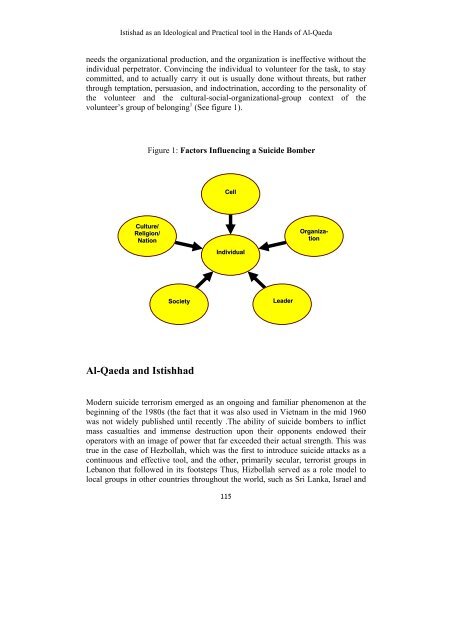222467to222472
222467to222472
222467to222472
You also want an ePaper? Increase the reach of your titles
YUMPU automatically turns print PDFs into web optimized ePapers that Google loves.
Istishad as an Ideological and Practical tool in the Hands of Al-Qaeda<br />
needs the organizational production, and the organization is ineffective without the<br />
individual perpetrator. Convincing the individual to volunteer for the task, to stay<br />
committed, and to actually carry it out is usually done without threats, but rather<br />
through temptation, persuasion, and indoctrination, according to the personality of<br />
the volunteer and the cultural-social-organizational-group context of the<br />
volunteer’s group of belonging 1 (See figure 1).<br />
Figure 1: Factors Influencing a Suicide Bomber<br />
Cell<br />
Culture/<br />
Religion/<br />
Nation<br />
Organization<br />
Individual<br />
Society<br />
Leader<br />
Al-Qaeda and Istishhad<br />
Modern suicide terrorism emerged as an ongoing and familiar phenomenon at the<br />
beginning of the 1980s (the fact that it was also used in Vietnam in the mid 1960<br />
was not widely published until recently .The ability of suicide bombers to inflict<br />
mass casualties and immense destruction upon their opponents endowed their<br />
operators with an image of power that far exceeded their actual strength. This was<br />
true in the case of Hezbollah, which was the first to introduce suicide attacks as a<br />
continuous and effective tool, and the other, primarily secular, terrorist groups in<br />
Lebanon that followed in its footsteps Thus, Hizbollah served as a role model to<br />
local groups in other countries throughout the world, such as Sri Lanka, Israel and<br />
115


